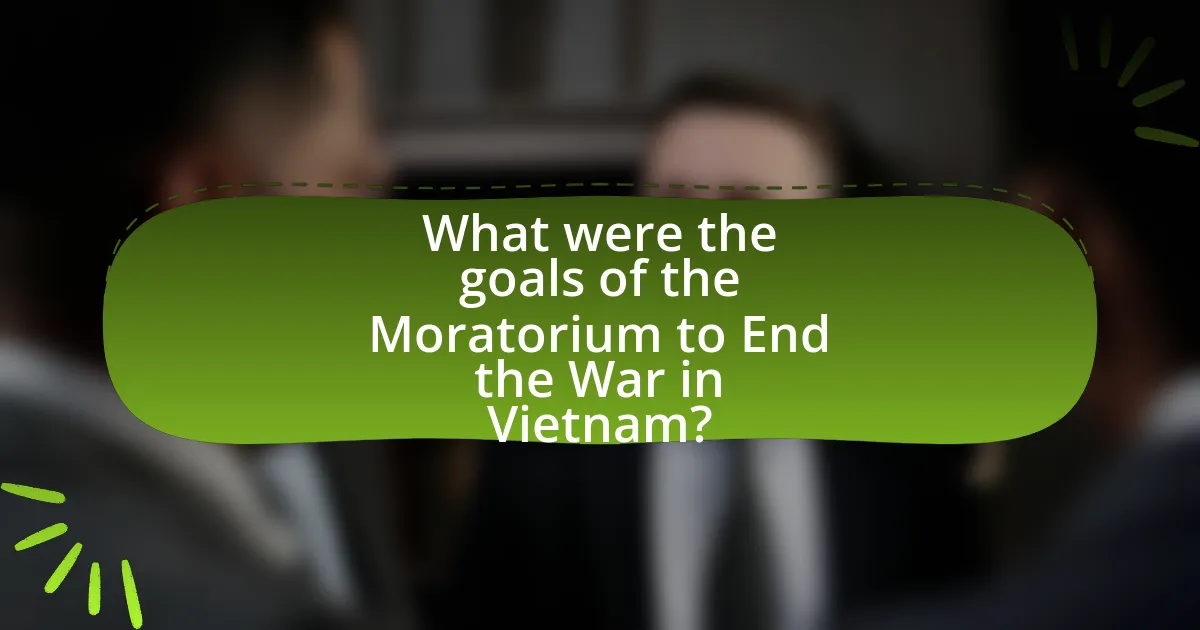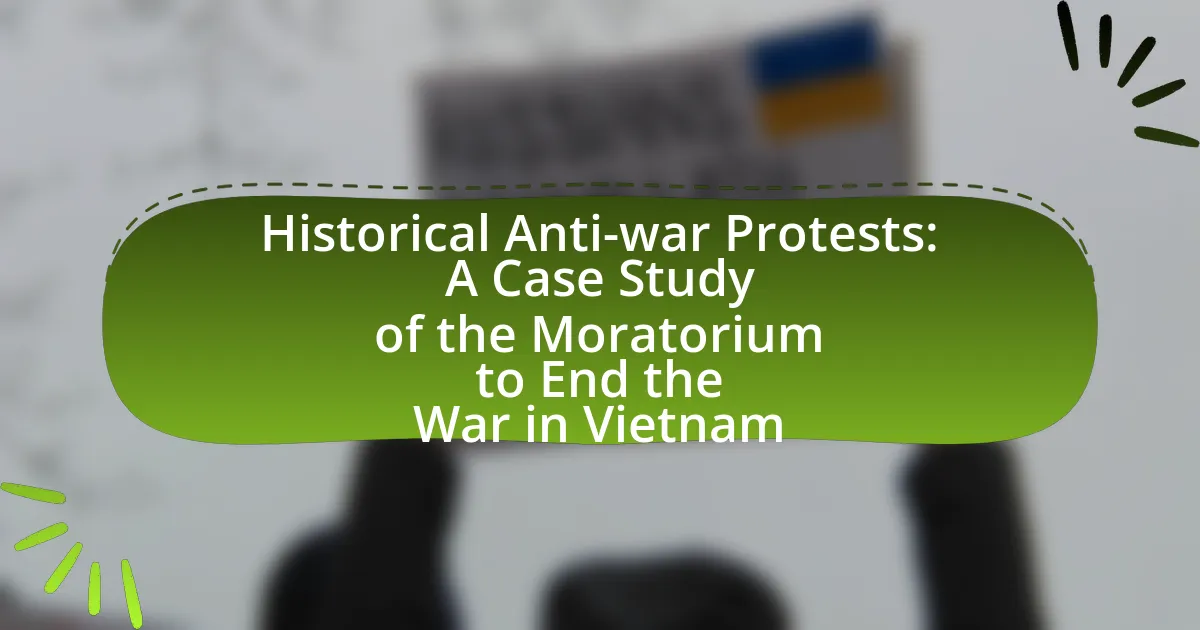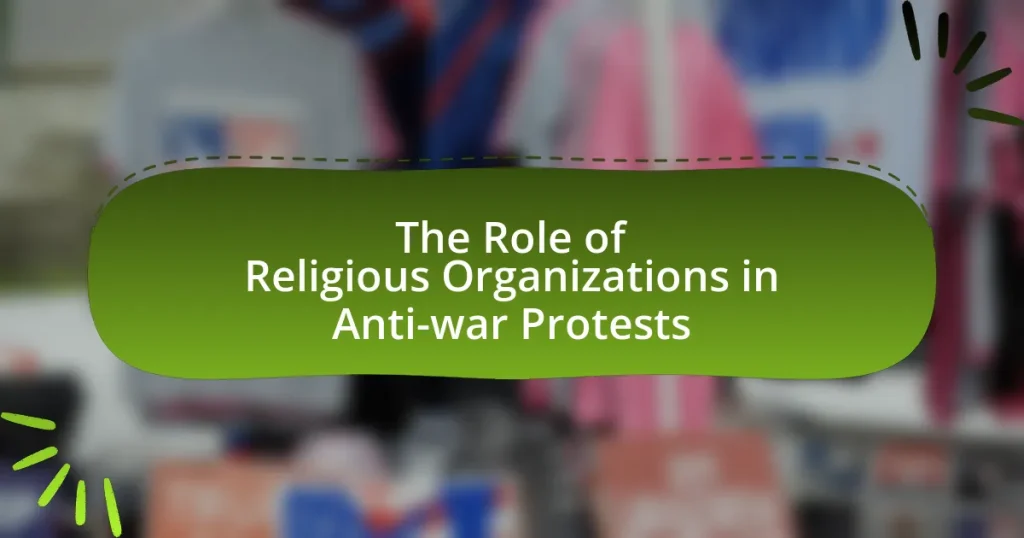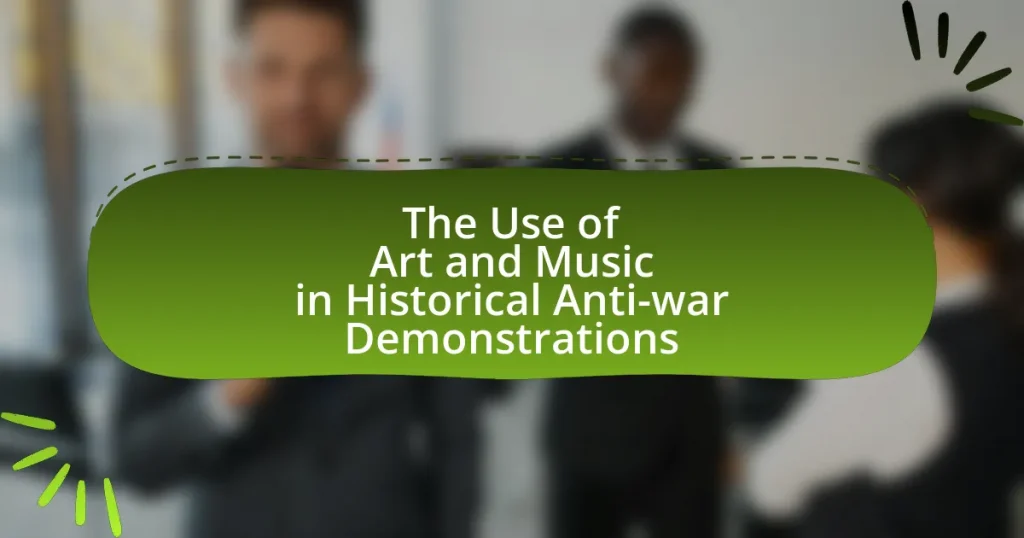The article examines the historical anti-war protests during the Vietnam War, with a particular focus on the Moratorium to End the War in Vietnam, which emerged in 1969 as a significant movement opposing U.S. military involvement. It details key events leading to the Moratorium, including the Gulf of Tonkin Resolution and the Tet Offensive, and highlights the roles of various organizers and participants. The article also discusses the impact of these protests on public opinion, government responses, and subsequent anti-war movements, emphasizing the importance of grassroots mobilization and media coverage in shaping the anti-war narrative. Additionally, it outlines the lessons learned from the Moratorium and best practices for organizing modern protests.

What were the Historical Anti-war Protests during the Vietnam War?
The historical anti-war protests during the Vietnam War were significant movements opposing U.S. involvement in Vietnam, marked by large-scale demonstrations and organized events. Notable protests included the 1969 Moratorium to End the War in Vietnam, which saw millions of Americans participating in various activities, including marches and sit-ins, to express their dissent. The protests were fueled by growing public discontent over the war’s human cost, exemplified by events such as the My Lai Massacre in 1968, which revealed the brutal realities of the conflict. Additionally, the Kent State shootings in 1970, where four students were killed by National Guardsmen during a protest, intensified anti-war sentiment and mobilized further activism across the nation. These protests played a crucial role in shaping public opinion and ultimately contributed to the U.S. decision to withdraw from Vietnam.
How did the Moratorium to End the War in Vietnam emerge?
The Moratorium to End the War in Vietnam emerged as a significant anti-war movement in the United States during the late 1960s, primarily driven by widespread public discontent with the Vietnam War. This movement gained momentum following the escalation of U.S. military involvement in Vietnam, particularly after the Tet Offensive in January 1968, which shocked the American public and intensified anti-war sentiments. The Moratorium was formally initiated on October 15, 1969, when millions of Americans participated in protests, rallies, and demonstrations across the country, reflecting a collective demand for the withdrawal of U.S. troops from Vietnam. The event was organized by a coalition of anti-war groups, including the National Mobilization Committee to End the War in Vietnam, which sought to unify various factions of the anti-war movement and amplify their message.
What were the key events leading to the Moratorium?
The key events leading to the Moratorium to End the War in Vietnam included the escalation of U.S. military involvement in Vietnam, the growing anti-war sentiment among the American public, and significant protests organized by various groups. The Gulf of Tonkin Resolution in 1964 marked a pivotal moment, as it allowed for increased military action, which intensified opposition. In 1965, the first major anti-war protests occurred, mobilizing thousands and setting the stage for larger demonstrations. By 1969, the anti-war movement gained momentum, culminating in the Moratorium on October 15, 1969, where millions participated in nationwide protests, reflecting widespread discontent with the war. These events collectively demonstrated the shift in public opinion and the urgency for a cessation of hostilities in Vietnam.
Who were the main organizers of the Moratorium?
The main organizers of the Moratorium to End the War in Vietnam were a coalition of anti-war activists, including prominent figures such as David Dellinger, who was a leader in the anti-war movement, and the National Mobilization Committee to End the War in Vietnam. This coalition included various organizations, such as the Students for a Democratic Society and the Women’s Strike for Peace, which collectively mobilized millions of Americans to participate in the nationwide protests on October 15, 1969. The Moratorium was significant as it represented one of the largest anti-war demonstrations in U.S. history, showcasing widespread public opposition to the Vietnam War.
Why were anti-war protests significant during the Vietnam War?
Anti-war protests were significant during the Vietnam War because they mobilized public opinion against U.S. involvement and influenced government policy. These protests, particularly the Moratorium to End the War in Vietnam in 1969, saw millions of Americans participating, which highlighted widespread dissent and shifted perceptions about the war. The protests were pivotal in raising awareness of the war’s human and economic costs, exemplified by the Tet Offensive in 1968, which contradicted government claims of progress. This growing opposition ultimately pressured political leaders to reconsider their strategies, contributing to the eventual withdrawal of U.S. troops in 1973.
What impact did these protests have on public opinion?
The protests significantly shifted public opinion against the Vietnam War. By mobilizing large numbers of participants and garnering extensive media coverage, these protests raised awareness about the war’s human and ethical costs. Polls conducted during the late 1960s indicated a marked increase in opposition to the war, with a Gallup poll in 1971 showing that 61% of Americans believed the U.S. should withdraw troops. This growing dissent influenced political leaders and contributed to the eventual decision to de-escalate U.S. involvement in Vietnam.
How did the government respond to the protests?
The government responded to the protests by implementing a combination of repression and public relations strategies. In response to the Moratorium to End the War in Vietnam, authorities increased police presence at demonstrations, leading to arrests and confrontations. Additionally, government officials attempted to counter the anti-war narrative through media campaigns that emphasized the importance of national security and the need to support troops. This dual approach aimed to maintain order while attempting to sway public opinion in favor of the war effort.

What were the goals of the Moratorium to End the War in Vietnam?
The goals of the Moratorium to End the War in Vietnam were to mobilize public opposition to the Vietnam War and to pressure the U.S. government to withdraw troops from Vietnam. This movement aimed to raise awareness about the war’s human and economic costs, advocating for peace and justice. The Moratorium, which included nationwide protests and demonstrations on October 15, 1969, sought to unify various anti-war groups and individuals, emphasizing the need for an immediate end to U.S. military involvement in Vietnam. The event drew millions of participants, showcasing widespread discontent and contributing to the growing anti-war sentiment in the United States.
What specific actions were taken during the Moratorium?
During the Moratorium to End the War in Vietnam, specific actions included nationwide protests, rallies, and demonstrations organized by various anti-war groups. These events took place on October 15, 1969, and involved millions of participants across the United States, highlighting public opposition to the Vietnam War. The Moratorium also featured teach-ins, where speakers educated attendees about the war’s implications, and the distribution of literature to raise awareness. The actions aimed to pressure the government to withdraw U.S. troops from Vietnam and to foster a broader anti-war sentiment among the American public.
How did the Moratorium mobilize participants across the country?
The Moratorium mobilized participants across the country by organizing nationwide demonstrations and events that unified anti-war sentiments. This grassroots movement, which peaked on October 15, 1969, saw over two million Americans participating in various activities, including rallies, vigils, and educational forums. The Moratorium’s effective use of media and local organizing efforts helped to spread awareness and encourage involvement, leading to significant participation from diverse communities. The event’s scale and visibility demonstrated widespread opposition to the Vietnam War, reinforcing the collective voice of dissent across the nation.
What messages were conveyed through the Moratorium events?
The Moratorium events conveyed strong anti-war messages emphasizing the need for peace and the urgency to end U.S. involvement in the Vietnam War. These events highlighted widespread public discontent with the war, showcasing the belief that continued military engagement was unjust and detrimental to both American soldiers and Vietnamese civilians. The Moratoriums mobilized millions of participants, demonstrating a collective demand for a change in U.S. foreign policy, which was evidenced by the significant turnout of over two million people nationwide on the peak day of protests in October 1969. This mass mobilization served as a clear indication of the growing anti-war sentiment across diverse segments of American society.
What were the outcomes of the Moratorium to End the War in Vietnam?
The outcomes of the Moratorium to End the War in Vietnam included a significant increase in public awareness and opposition to the Vietnam War, as well as a mobilization of diverse groups advocating for peace. The Moratorium, which took place on October 15, 1969, saw millions of Americans participating in protests, rallies, and demonstrations across the country, highlighting the growing discontent with U.S. involvement in Vietnam. This widespread participation demonstrated a shift in public sentiment, contributing to a decline in support for the war and influencing political discourse. Additionally, the Moratorium helped to galvanize various anti-war organizations, leading to sustained activism that pressured the government to reconsider its military strategy in Vietnam.
How did the Moratorium influence subsequent anti-war movements?
The Moratorium significantly influenced subsequent anti-war movements by establishing a model for large-scale, organized protests that effectively mobilized public sentiment against the Vietnam War. This event, which peaked on October 15, 1969, saw millions of Americans participating in demonstrations, thereby demonstrating the potential for grassroots activism to impact national policy. The success of the Moratorium inspired later movements, such as the protests against U.S. involvement in Central America during the 1980s and the anti-Iraq War demonstrations in the early 2000s, which adopted similar strategies of mass mobilization and public engagement. The Moratorium’s emphasis on inclusivity and coalition-building among diverse groups also set a precedent for future anti-war efforts, highlighting the importance of unity across various demographics in advocating for peace.
What legislative or policy changes resulted from the Moratorium?
The Moratorium to End the War in Vietnam led to significant legislative and policy changes, including the eventual reduction of U.S. troop levels in Vietnam and the shift towards a policy of Vietnamization. This shift aimed to transfer combat responsibilities to South Vietnamese forces while gradually withdrawing American troops. The Moratorium also influenced public opinion, which pressured Congress to reconsider military funding and oversight, ultimately contributing to the passage of the War Powers Act in 1973. This act aimed to limit the President’s ability to engage U.S. forces without congressional approval, reflecting a legislative response to the anti-war sentiment galvanized by the Moratorium.

How did the Moratorium to End the War in Vietnam reflect broader societal changes?
The Moratorium to End the War in Vietnam reflected broader societal changes by mobilizing a diverse coalition of Americans who opposed the war, highlighting a shift in public sentiment towards anti-war activism. This event, particularly on October 15, 1969, saw over two million participants nationwide, indicating a significant increase in public dissent against government policies. The Moratorium also showcased the growing influence of grassroots movements, as it was organized by a coalition of students, veterans, and civil rights activists, demonstrating a unification of various social movements. This collective action was a response to the increasing awareness of the war’s human and economic costs, as evidenced by the rising casualty figures and the impact on American society, which fueled demands for peace and justice.
What role did media play in shaping the Moratorium’s impact?
Media played a crucial role in shaping the impact of the Moratorium to End the War in Vietnam by amplifying public awareness and mobilizing support for the anti-war movement. Through extensive coverage, including television broadcasts, newspaper articles, and radio segments, media outlets informed the public about the scale of the protests and the sentiments of participants, which helped to legitimize the movement. For instance, the Moratorium on October 15, 1969, was reported as one of the largest anti-war demonstrations in U.S. history, with millions participating nationwide, thus highlighting the widespread opposition to the war. This coverage not only increased visibility but also encouraged more individuals to join the protests, creating a feedback loop that further intensified media interest and public engagement.
How did the portrayal of the Moratorium in the media affect public perception?
The portrayal of the Moratorium in the media significantly shaped public perception by amplifying anti-war sentiments and mobilizing widespread participation. Major news outlets covered the events extensively, showcasing large gatherings and emotional testimonies from participants, which helped humanize the anti-war movement. For instance, the coverage of the Moratorium on October 15, 1969, highlighted the participation of over two million Americans, creating a visual and emotional impact that resonated with the public. This extensive media attention contributed to a growing perception that opposition to the Vietnam War was not only widespread but also a legitimate and necessary stance, ultimately influencing public opinion and political discourse surrounding the war.
What were the reactions from different demographic groups to the Moratorium?
The reactions from different demographic groups to the Moratorium varied significantly. Young people, particularly college students, largely supported the Moratorium, participating in protests and rallies to express their opposition to the Vietnam War. In contrast, older generations, including many veterans and conservative groups, often criticized the Moratorium, viewing it as unpatriotic and disrespectful to military service. Additionally, African American communities showed mixed reactions; while some supported the Moratorium as part of a broader anti-war sentiment, others felt that the focus should remain on civil rights issues rather than the war. This diversity in reactions highlights the complex social dynamics surrounding the Moratorium and its impact across various segments of society.
What lessons can be learned from the Moratorium to End the War in Vietnam?
The Moratorium to End the War in Vietnam teaches the importance of grassroots mobilization in influencing public policy. This large-scale protest, which peaked in 1969, demonstrated that organized, peaceful demonstrations could effectively raise awareness and pressure government officials to reconsider their positions on contentious issues. The event mobilized millions of Americans, showcasing the power of collective action and the role of civil society in shaping political discourse. Historical data indicates that the Moratorium significantly impacted public opinion, contributing to a decline in support for the Vietnam War and ultimately influencing U.S. withdrawal strategies.
How can contemporary movements draw inspiration from the Moratorium?
Contemporary movements can draw inspiration from the Moratorium by adopting its strategies of mass mobilization and grassroots organization. The Moratorium, which saw millions participate in protests against the Vietnam War in 1969, demonstrated the power of collective action in influencing public opinion and policy. By utilizing similar tactics, such as coordinated demonstrations, social media campaigns, and community engagement, modern movements can effectively raise awareness and galvanize support for their causes. Historical evidence shows that the Moratorium significantly impacted U.S. policy regarding Vietnam, illustrating how sustained activism can lead to tangible change.
What strategies proved effective in mobilizing support during the Moratorium?
Effective strategies for mobilizing support during the Moratorium included grassroots organizing, coalition-building, and the use of media to amplify messages. Grassroots organizing involved local groups mobilizing communities through meetings, rallies, and educational events, which fostered a sense of collective action. Coalition-building brought together diverse organizations, including student groups, religious institutions, and civil rights organizations, which expanded the reach and legitimacy of the movement. The strategic use of media, particularly television and print, helped to disseminate the Moratorium’s messages widely, reaching audiences beyond the immediate participants and increasing public awareness and support for the anti-war cause. These strategies collectively contributed to the Moratorium’s significant impact on public opinion regarding the Vietnam War.
What are the best practices for organizing modern anti-war protests?
The best practices for organizing modern anti-war protests include clear messaging, strategic planning, and effective mobilization. Clear messaging ensures that the purpose of the protest is easily understood, which can be achieved by using concise slogans and informative materials. Strategic planning involves selecting appropriate locations, dates, and times that maximize visibility and participation; for instance, protests near government buildings or during significant political events can attract more attention. Effective mobilization relies on utilizing social media platforms to reach a wider audience, as evidenced by the success of movements like the Women’s March, which effectively used online tools to organize and inform participants. Additionally, forming coalitions with other organizations can enhance resources and outreach, as seen in various historical protests where collaboration amplified impact.



